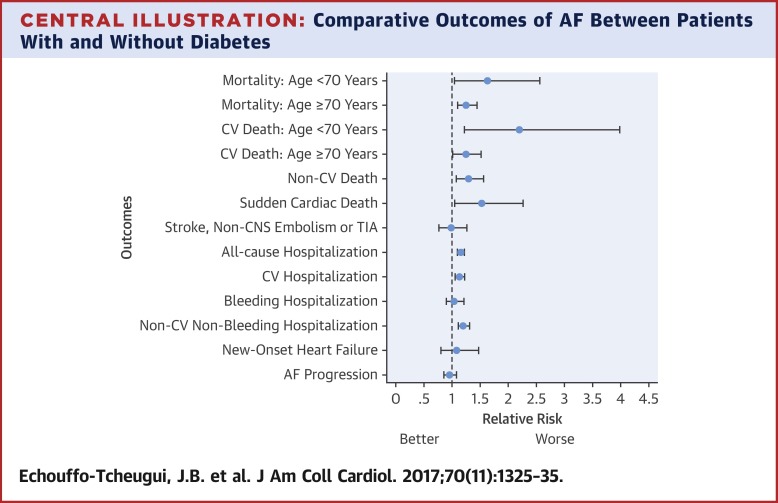当前位置:
X-MOL 学术
›
J. Am. Coll. Cardiol.
›
论文详情
Our official English website, www.x-mol.net, welcomes your
feedback! (Note: you will need to create a separate account there.)
Care Patterns and Outcomes in Atrial Fibrillation Patients With and Without Diabetes
Journal of the American College of Cardiology ( IF 21.7 ) Pub Date : 2017-09-01 , DOI: 10.1016/j.jacc.2017.07.755 Justin B. Echouffo-Tcheugui , Peter Shrader , Laine Thomas , Bernard J. Gersh , Peter R. Kowey , Kenneth W. Mahaffey , Daniel E. Singer , Elaine M. Hylek , Alan S. Go , Eric D. Peterson , Jonathan P. Piccini , Gregg C. Fonarow
Journal of the American College of Cardiology ( IF 21.7 ) Pub Date : 2017-09-01 , DOI: 10.1016/j.jacc.2017.07.755 Justin B. Echouffo-Tcheugui , Peter Shrader , Laine Thomas , Bernard J. Gersh , Peter R. Kowey , Kenneth W. Mahaffey , Daniel E. Singer , Elaine M. Hylek , Alan S. Go , Eric D. Peterson , Jonathan P. Piccini , Gregg C. Fonarow

|
BACKGROUND
Diabetes is a well-established risk factor for thromboembolism in patients with atrial fibrillation (AF), but less is known about how diabetes influences outcomes among AF patients. OBJECTIVES
This study assessed whether symptoms, health status, care, and outcomes differ between AF patients with and without diabetes. METHODS
The cohort study included 9,749 patients from the ORBIT-AF (Outcomes Registry for Better Informed Treatment of Atrial Fibrillation) registry, a prospective, nationwide, outpatient registry of patients with incident and prevalent AF. Outcomes included symptoms, health status, and AF treatment, as well as 2-year risk of death, hospitalization, thromboembolic events, heart failure (HF), and AF progression. RESULTS
Patients with diabetes (29.5%) were younger, more likely to have hypertension, chronic kidney disease, HF, coronary heart disease, and stroke. Compared to patients without diabetes, patients with diabetes also had a lower Atrial Fibrillation Effects on Quality of Life score of 80 (interquartile range [IQR]: 62.5 to 92.6) versus 82.4 (IQR: 67.6 to 93.5; p = 0.025) and were more likely to receive anticoagulation (p < 0.001). Diabetes was associated with higher mortality risk, including overall (adjusted hazard ratio [aHR]: 1.63; 95% confidence interval [CI]: 1.04 to 2.56, for age <70 years vs. aHR: 1.25; 95% CI: 1.09 to 1.44, for age ≥70 years) and cardiovascular (CV) mortality (aHR: 2.20; 95% CI: 1.22 to 3.98, for age <70 years vs. 1.24; 95% CI: 1.02 to 1.51 for age ≥70 years). Diabetes conferred a higher risk of non-CV death, sudden cardiac death, hospitalization, CV hospitalization, and non-CV and nonbleeding-related hospitalization, but no increase in risks of thromboembolic events, bleeding-related hospitalization, new-onset HF, and AF progression. CONCLUSIONS
Among AF patients, diabetes was associated with worse AF symptoms and lower quality of life, and increased risk of death and hospitalizations, but not thromboembolic or bleeding events.
中文翻译:

糖尿病和非糖尿病房颤患者的护理模式和结果
背景 糖尿病是心房颤动 (AF) 患者血栓栓塞的公认危险因素,但人们对糖尿病如何影响 AF 患者的预后知之甚少。目的 本研究评估了合并和不合并糖尿病的 AF 患者的症状、健康状况、护理和结果是否不同。方法 该队列研究包括来自 ORBIT-AF(更好地治疗房颤的结果登记处)登记处的 9,749 名患者,该登记处是一项前瞻性、全国性的门诊登记处,对突发性和流行性 AF 患者进行登记。结果包括症状、健康状况和 AF 治疗,以及 2 年死亡风险、住院风险、血栓栓塞事件、心力衰竭 (HF) 和 AF 进展。结果 糖尿病患者 (29.5%) 更年轻,更可能患有高血压、慢性肾病、HF、冠心病和中风。与没有糖尿病的患者相比,糖尿病患者的房颤对生活质量的影响评分也较低,为 80(四分位距 [IQR]:62.5 至 92.6)与 82.4(IQR:67.6 至 93.5;p = 0.025),并且更高可能接受抗凝治疗(p < 0.001)。糖尿病与更高的死亡风险相关,包括总体(调整风险比 [aHR]:1.63;95% 置信区间 [CI]:1.04 至 2.56,年龄<70 岁 vs. aHR:1.25;95% CI:1.09 至 1.44 ,年龄≥70 岁)和心血管(CV)死亡率(aHR:2.20;95% CI:1.22 至 3.98,年龄 <70 岁 vs. 1.24;95% CI:1.02 至 1.51,年龄 ≥70 岁)。糖尿病导致非心血管死亡、心脏性猝死、住院、心血管住院以及非心血管和非出血相关住院的风险更高,但不会增加血栓栓塞事件、出血相关住院、新发 HF 和 AF 进展的风险。结论 在房颤患者中,糖尿病与房颤症状加重、生活质量降低、死亡和住院风险增加有关,但与血栓栓塞或出血事件无关。
更新日期:2017-09-01
中文翻译:

糖尿病和非糖尿病房颤患者的护理模式和结果
背景 糖尿病是心房颤动 (AF) 患者血栓栓塞的公认危险因素,但人们对糖尿病如何影响 AF 患者的预后知之甚少。目的 本研究评估了合并和不合并糖尿病的 AF 患者的症状、健康状况、护理和结果是否不同。方法 该队列研究包括来自 ORBIT-AF(更好地治疗房颤的结果登记处)登记处的 9,749 名患者,该登记处是一项前瞻性、全国性的门诊登记处,对突发性和流行性 AF 患者进行登记。结果包括症状、健康状况和 AF 治疗,以及 2 年死亡风险、住院风险、血栓栓塞事件、心力衰竭 (HF) 和 AF 进展。结果 糖尿病患者 (29.5%) 更年轻,更可能患有高血压、慢性肾病、HF、冠心病和中风。与没有糖尿病的患者相比,糖尿病患者的房颤对生活质量的影响评分也较低,为 80(四分位距 [IQR]:62.5 至 92.6)与 82.4(IQR:67.6 至 93.5;p = 0.025),并且更高可能接受抗凝治疗(p < 0.001)。糖尿病与更高的死亡风险相关,包括总体(调整风险比 [aHR]:1.63;95% 置信区间 [CI]:1.04 至 2.56,年龄<70 岁 vs. aHR:1.25;95% CI:1.09 至 1.44 ,年龄≥70 岁)和心血管(CV)死亡率(aHR:2.20;95% CI:1.22 至 3.98,年龄 <70 岁 vs. 1.24;95% CI:1.02 至 1.51,年龄 ≥70 岁)。糖尿病导致非心血管死亡、心脏性猝死、住院、心血管住院以及非心血管和非出血相关住院的风险更高,但不会增加血栓栓塞事件、出血相关住院、新发 HF 和 AF 进展的风险。结论 在房颤患者中,糖尿病与房颤症状加重、生活质量降低、死亡和住院风险增加有关,但与血栓栓塞或出血事件无关。











































 京公网安备 11010802027423号
京公网安备 11010802027423号